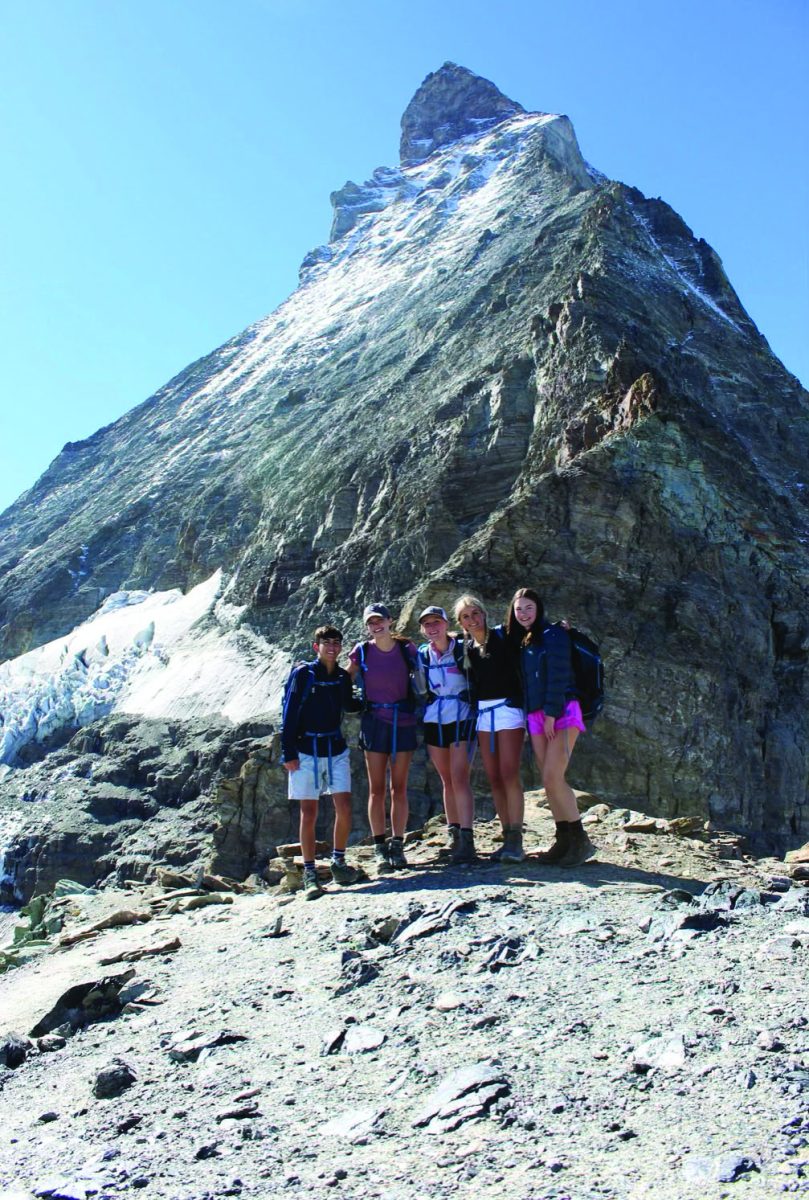It’s a peaceful Sunday morning on the patio. A soothing breeze sends a chill up your arm, but a cup of aromatic coffee warms up your side. Raising the cup, you drink the last sip of your dark roasted coffee and your eyes wander around the room, eventually falling on the classic blue-and-white Maxwell House brand container. “Good to the Last Drop” is imprinted on the coffee container. You put down the empty cup and move to the toast, as the perfect Sunday morning continues.
Yet, what if that empty cup you just put down held that “Last Drop” of coffee on Earth?
SAY GOODBYE TO YOUR FAVORITE FOODS
On Land
Despite ongoing disputes about global warming and the human impact on the world, one thing is clear: the Earth’s climate is changing, and many of the Earth’s animals, plants and ecosystems are on the brink of extinction. According to an article by The Guardian, over 120 million people worldwide rely on the coffee industry as their primary source of income. And 100 million Americans drink coffee daily.Scientists quoted in aUK Independent article, however, have said this popular beverage is destined to go extinct in 60 years. The primary ingredient, the coffee bean, is threatened by climate change.
“More and more extreme weather events in major coffee-producing regions seem set to create supply shortages, and hotter conditions will impair flavour and aroma,” The Climate Institute wrote in the “A Brewing Storm” report.
The Coffee Berry Borer, a beetle which buries and lays its eggs in coffee bean bearing plants, is spreading to higher regions and destroying coffee bean plants in its wake. The beetle is drawn to wet, hot environments. Climate change has brought an increase of these types of environments, and thus, the beetle is found to live 300 meters higher than where they lived last century. With every meter higher they migrate, that is another meter of coffee plant deaths. “The Earth does go through cycles of warm and cold and the temperature swings a great deal over long geological periods. I think the difference is simply in how quickly things are happening right now,” Bartlett said.
And this is a domino effect: the earth’s temperature quickly rises, more humid environments are created, the beetles expand and the coffee bean plants die. Studies by the Ethiopian Environment and Coffee Forest Forum have predicted that the best case scenario for wild coffee plants is a 65 percent decrease by 2080 while the worst case is a 99.7 percent site reduction.
But coffee is not the only doomed bean. Recent studies from the National Oceanic and Atmospheric Administration have revealed that the chocolate bean will most likely go extinct by the year 2050. The natural source of chocolate, the cacao plant, is dying out.
And who is the culprit behind the decline of chocolate? Climate change.
“More than 90 percent of the global cocoa crop is produced by smallholders on subsistence farms with unimproved planting material,” British researcher Doug Hawkins told the Daily Mail.
Cacao trees are victims of fungal diseases commonly triggered by climate change. According to an article by the Scientific American, fungal diseases, including frosty pod and witch’s broom, attack cacao plants primarily in their native Central America. Cacao trees are very specific to their environment as they need an extremely humid atmosphere with fairly warm temperatures, nitrogen-rich soil and wind protection. Thus, these fungal attacks on one of the few places in which cacao trees flourish could lead to the species demise.
Sophomore Riyana Daulat, president of the Hockaday All Green Club, said “I don’t think I could live without chocolate.”
Think these are the only foods at risk? Nope, it turns out that there are other foods at risk as well. According to Business Insider, some foods, including avocados and chickpeas, are at risk because of the increasing worldwide droughts that climate change is causing. While others, such as maple syrup and peanuts, are going extinct because the stable weather conditions they require for their production are reducing more and more with climate change.
Under the Sea
The old saying goes: “There are plenty of fish in the sea…” However the oceans’ fish are quickly depleting.
According to studies by the International Union for Conservation of Nature, at least 1,414 species of saltwater fish are estimated to go extinct by 2048.
Researcher Nicola Beaumont, Ph.D., of the Plymouth Marine Laboratory told CBS News “If Biodiversity continues to decline, the marine environment will not be able to sustain our way of life. Indeed, it may not be able to sustain our lives at all.”
The extinction of salt-water fish won’t only be a loss in the variety of foods we eat, but it will also cause a risk to the safety of the shorelines, as fish protect them. In addition, there will be a surge in algae and toxins in the ocean, because the fish that filter these will be extinct.
According to a Scientific American Article, between 1970 and 2012, the fish population in the ocean has reduced by 50 percent. And, with some commercial species, including bonito and tuna, the reductions of these species have plunged by nearly 75 percent.
According to the Smithsonian Institution, ocean waters have become at least 30 percent more acidic as a result of warming global temperatures, causing damage to coral reefs, the natural nurseries to the majority of fish. While the damage to coral reefs is killing adolescent fish, overfishing is wiping out the adult fish population.
While many groups across the globe are attempting to protect the fish species, less than four percent of global oceans are effectively protected, according to an article published by Science Daily.
But fish are not the only things being affected under the sea. As many of the Earth’s ecosystems are being thrown off balance by climate change, tourist attractions around the globe are disappearing fast. One of the main contributing factors of the decline in global ecosystems is the rising surface temperature of the ocean. The Great Barrier Reef, which stretches 2,300 kilometers off the coast of Queensland, Australia, is one of the seven natural wonders of the world and a UNESCO World Heritage Site. In recent years, however, the reef has been greatly affected by coral bleaching, a process in which warm water triggers the growth of algae that eventually kills the coral.
According to Sean Connolly, the program leader of a government-funded coral reef center at James Cook University, Queensland, in an interview with CNN, 91 percent of the Great Barrier Reef is affected by bleaching, and 50 percent is severely bleached. Now, some scientists predict that the reef, home to one of the world’s richest ocean habitats, could disappear by 2050.
Our Cities
As the temperature of the ocean continues to rise, sea level also increases. NASA measures that the global sea level rises at a rate of 3.2 millimeters per year, and this change is detrimental to coastal areas of the world.
Known for its gorgeous beaches, the Republic of Maldives is one of the most sought-after tourist destinations in the world. Maldives, however, is the flattest country on Earth. According to the Climate Hot Map, 77 percent of the country’s will be underwater by 2100.
Called the “City of Water,” Venice is also sinking fast. The canals and waterways that the city is known for will contribute to its demise. Experts predict that this Italian landmark could disappear by the end of the century. The United States will not get spared. Our country is projected to lose considerable areas of land due to a rising sea level. The New York Times estimates that in 100 to 300 years, almost all of New Orleans will be underwater. Twenty percent of Florida will be submerged, with 94 percent of Miami Beach completely wiped out.
Scientists also predict that rising temperatures will render some cities in the Middle East uninhabitable by the end of the century. The predicted heat wave will affect parts of Qatar, the United Arab Emirates, Bahrain, Saudi Arabia, and other countries. According to a study from the Nature Climate Change journal, countries near the Persian gulf will experience temperatures ranging from 74°C (165°F) to 76°C (169°F) in midday.
An article from the Independent points out that the temperature will be so high that the human body cannot produce sweat to expel the heat.
Senior Hibah Naviwala moved to Saudi Arabia five years ago, and she worries that this prediction might come true.
“One thing I noticed when I moved there five years ago is that there are alot of sand storms during the winter, but not so much during the summer. Now, when I go home during the summers, we have sand storms,” Naviwala said.
According to an article published by Princeton University, increasing sand storms in the Middle East are likely due to extreme arid conditions caused by climate change.
Human Activity
Human activity also plays a central role in the change of these ecosystems around the world. Scientists have recognized that we are now living in a new human-dominated epoch termed “Anthropocene,” and evidence suggests that human activity is now the most important geological force on the planet.
Upper School Science Department Chair Marshall Bartlett, Ph.D, recognizes the power of human activities on the environment.
“Human beings, particularly with the technology we have today, can make very large changes to the environment in very short periods of time,” Bartlett said.
The fate of one ecosystem, Antarctica, is under the looming threat of future human activity. The white continent of Antarctica holds a unique place on the planet. Under the 1991 Protocol on Environmental Protection to the Antarctic Treaty, Antarctica is a “natural reserve, devoted to peace and science” (Art. 2) and belongs to no country.
In 2048, however, the agreement under the treaty that bans mining activity in Antarctica will be up for review, which would open the frozen continent up to commercial mining that will be detrimental to the environment of Antarctica. If the demand of coal continues to increase, this rich cradle of life will face great danger.
Many ecosystems native to North Texas are also vanishing due to human activities. Lewisville Lake Environmental Learning Area, a North Texas nature preserve, is dedicated to restoring native Texas ecosystems and provide education and information to visitors.
According to LLELA, before Americans pushed westward into the lands of Texas, the North Texan prairies were filled with plant species like little bluestem, big bluestem, sideoats grama, indiangrass and buffalo grass. After about 150 years of human activity, less than 0.01 percent of this ecosystem remains.
Walking A Tightrope
The world’s ecosystems seem to be slipping through our fingers. In the wake of Hurricane Harvey and Hurricane Irma, the nation is forced to face the realities of climate change. But we find ourselves walking a tightrope: a balance between conservation and development.
Energy consumption is the largest source of greenhouse gas emissions, and historically, it has always proceeded hand-in-hand with development. As a result, developing countries take a deadly toll on the environment by heavily investing in fossil fuels to boost their economy. However, according to Bartlett, conservation of the environment will become critical to developing the economy in the future.
“As you go forward in time, climate change is going to alter real estate values. There are some places that will be more attractive to live in, and others that are attractive right now will be less attractive to live in,” Bartlett said, “I think climate change is going to change the economics of where we get our food from. How much food costs, what the production costs of food are.”
Bartlett believes that the political content of climate change will only increase over time.
“When we move into the range of us saying ‘Now this problem is on par with global poverty or education policy,’ we have to start making hard choices about where we devote our resources to,” Bartlett said.
Developing countries have always been the frontier of environment-related discussions. Struggling to maintain the balance between economic advancement and environmental friendliness, some developing countries have started their process of leaning towards conservation.
China, being the one of the representing nations under rapid developments, has evolved a growing awareness towards environmental protection. Despite the serious air pollution in Northern Chinese areas, the Chinese government has been seeking for alternative solutions, aiming to effectively ameliorate the ongoing issues.
The use of advanced technologies, for example, has been one of the major focuses in the recent years. The Chinese government situated the “capital” of advanced technology developments and environmental conservation in Shenzhen, a mainland city facing Hong Kong.
The awareness of protecting the environment has been growing rapidly ever since the Chinese Economic Reform in 1978. After the economic reform, Shenzhen city has become the testing field of utilizing advanced technology in environmental conservation, leading the frontier of Chinese’s awareness of preserving environment. Winston Wu, deputy director of Shenzhen’s Development and Reformation Commission and father of Hockaday junior Emily Wu, suggests that low-carbon life and environmental conservation are being treated importantly in China.
“A common idea in China now is that we can’t expect to pollute the environment first and treat it after. We can no longer put economical development prior than environmental conservation anymore,” said Wu.
Despite making progresses, China still has a long way ahead. According to the Real-time Air Quality index, Beijing’s average index remains as Moderate (57), Hong Kong remains as Unhealthy (124), similar to Shanghai where the index shows Unhealthy (153). The city of Jinan, however, along with the areas around, still remain constantly on Hazardous (999).
Back in the U.S., President Donald Trump is pushing an anti-conservation agenda. In June 2017, the U.S. pulled out of the Paris Agreement, a now 194-country effort to reduce greenhouse gas emissions. Trump states that the agreement will “undermine our economy.” According to an article in the New York Times, published in Dec. 2017, 700 officials in the E.P.A. have resigned since President Trump took office. The near future of federal conservation is uncertain.
However, Mariana Pickering ’00 believes that there is a far but tangible future where conservation and city development may work in conjunction. With a background in architectural design, Pickering founded Emu Systems, now located in Denver, Colorado. Emu Systems is a company that offers professional training and consulting for the construction and design of sustainable buildings based on the Passive House Standard.
“If every building had a green roof we wouldn’t have any problems with permeability and having too much asphalt in our cities. If every building had a Passive House envelope in mechanical ventilation system, we would actually be using our buildings as a way to clean pollution because you’re filtering that air,” Pickering said. “There’s ways that the buildings, when you look at them collectively in the context of a city, can make that city become almost like a living organism.”
However, Pickering believes that we still have a long way to go before this becomes reality. Facing the situations close at hand, Texas locals are seeking to eliminate environmental issues from the roots. According to William Puplampu, assistant region attorney and regional counsel at the E.P.A. and father of Hockaday senior Lauren Puplampu, Texas is one of the most industrialized states in the United States.
“We have a lot of industries or vehicles that create a lot of emissions into the air and transportations and vehicles are the biggest factors that cause air pollution in Texas,” Puplampu said.
Multiple acts have been addressed to soothe the local environmental issues, while agencies like the E.P.A take charge to administer these acts.
“The E.P.A makes sure that states submit the air quality plan. We have to ensure that the plan meets the standard of the clean act. We also do similar things in every program and enforce the law that helps the environment.” Puplampu said.
Locally, major conservation efforts also depend on grassroots organizations like LLELA. “There are a lot of people fighting every day for a better environment in Texas,” Puplampu commented with regards to environmental NGOs.
Physical education coordinator at Hockaday Melinda Nunez is a regular visitor to the LLELA preserve.
“People who work there do a lot of work tracking what’s growing they grow a lot of the Texas native grasses and restore prairies,” Nunez said.
From global efforts to domestic reform and local activism, environmental conservation is moving up the agenda. Bartlett believes that future conservation will closely depend on human demand and market. For example, chocolate and coffee will likely receive priority in conservation due to their high demands.
“The things that are really in danger are the things that human beings find no essentially utilization for,” Bartlett said, “We look at them and say ‘Oh, sad that’s it’s not the way that it used to be,’ but without a human-based market-based incentive to preserve those things, or to propagate them in the future, they are at risk”
It’s hard to imagine a world without polar bears or coral reefs, but to what extent can our generation change the future?
“There’s lots of things around us that we look at and say that it’s a problem, a concern, a worry,” Bartlett said. “We have to pick our battles.”
Story by Emily Wu, Staff Writer, Michelle Chen, Asst. Web Editor, and Ashlye Dullye, Staff Writer
Photo by Michelle Chen and Emily Wu













